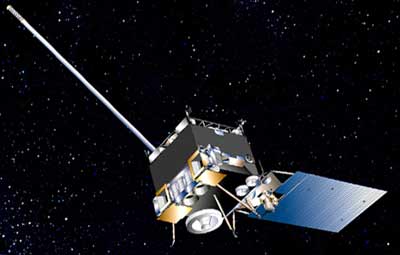Boeing EWS-G
Beginning in the mid-1970s, the civilian NOAA (National Oceanic and Atmospheric Administration) began to operate a number of geosynchronous meteorological satellites under the GOES (Geostationary Operational Environmental Satellites) label. The 4th block of GOES satellites, GOES-13 to -15, was built by Boeing as prime contractor, and launched between 2006 and 2010. The satellites use multi-spectral instruments to monitor the Earth's surface, oceans and cloud patterns in visible and infrared wavelengths. They also have sensors to monitor "space weather", i.e. solar flares, X-rays and particle emissions. The GOES satellites also have a communication suite to collect and distribute data from all sorts of ground-based meteorological, geological and oceanographic sensor systems.
GOES-13 was retired to reserve status in 2018, when it was replaced by GOES-15, the first in a new block of further improved satellites. In 2019, the U.S. Air Force had indentified a short-term need for an interim weather monitoring satellite, and acquired GOES-13 from the NOAA. The satellite was put back in service, and operated by the USAF (and later the U.S. Space Force) under the label EWS-G1 (EO/IR Weather System – Geostationary).
 |
| Image: Boeing |
| EWS-G |
GOES-15, having been put in reserve by the NOAA in 2020, was acquired by the USSF in September 2023 as EWS-G2. From November 2023 on, it replaced EWS-G1, which had been deactivated in October that year.
| Name | Intl. Designation | Launch | Notes |
|---|---|---|---|
| EWS-G1 | 2006-018A | 24-May-2006 | Originally launched as GOES-13 |
| EWS-G2 | 2010-008A | 04-Mar-2010 | Originally launched as GOES-15 |
Launch dates of the EWS-G series
Main Sources
[1] Wikipedia: GOES 13,
GOES 15
[2] Gunter Krebs: GOES N, O, P, Q
[3] USSF:
EO/IR Weather System – Geostationary
Back to Directory of U.S. Military Rockets and Missiles, Appendix 3
Last Updated: 15 April 2024